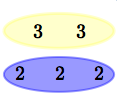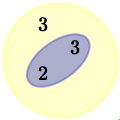 Relatively Prime Numbers and Related Concepts
Relatively Prime Numbers and Related Concepts
For ease of notation, in this section ‘number’ refers to a counting number: $\,1,\, 2,\, 3,\, \ldots\,$
The prime factorization of a number reveals its ‘multiplicative building blocks’— Jo Johansen uses the words ‘personality’ and ‘structure’ to refer to the prime factorization. The terms ‘unrelated’, ‘lives-in’, and ‘overlapping’ (below) are also credited to Jo. I love the images that this language connotes!
Jo has given me permission to share her insights about how ‘numbers converse with each other due to their personalities’ which gives ‘an efficient set of eyes through which the least common multiple (of two numbers) can be found expeditiously’.
There are three possible ways that two numbers can ‘relate’ to each other:
- relatively prime (unrelated, strangers)
- lives-in
- overlapping

$8\,$ and $\,9\,$ are relatively prime
$8\,$ and $\,9\,$ are unrelated
$8\,$ and $\,9\,$ are strangers

$6$ lives in $18$

$6\,$ overlaps $\,8\,$
Relatively Prime
Two numbers are relatively prime (informally: ‘unrelated’ or ‘strangers’) when they have no prime factor in common.
Examples
|
 $8\,$ and $\,9\,$ are relatively prime $8\,$ and $\,9\,$ are unrelated $8\,$ and $\,9\,$ are strangers |
When two numbers are relatively prime (unrelated, strangers), then their least common multiple is their product:
- The least common multiple of $\,8\,$ and $\,9\,$ is $\,8\cdot 9 = 72\,.$
- $\text{lcm}(3,5) = 3\cdot 5 = 15\,$
-
$\displaystyle\frac 17 + \frac1{10} = \frac{10}{70} + \frac{7}{70} = \frac{17}{70}$
Note that the Least Common Denominator (LCD), one important use of the Least Common Multiple (LCM), is $\,7\cdot 10 = 70\,.$
Relatively prime is an important mathematical concept, and hence deserves a formal definition:
Two counting numbers are relatively prime if and only if they have no common factor other than $\,1\,.$
Equivalently:
Two counting numbers are relatively prime if and only if their greatest common factor is $\,1\,.$
Lives-In
The ‘lives-in’ relationship says that one of the structures lives entirely inside the other. That is, one of the numbers contains all the prime factors of the other . It's easy to recognize the lives-in case, because the smaller number goes into the bigger one evenly.
Examples
|
 $18 = 2\cdot 3\cdot 3$ $6 = 2\cdot 3$ $6\,$ ‘lives in’ $\,18$ |
In the ‘lives-in’ case, the least common multiple is the bigger number. It's as if the larger number says: ‘Not to worry! I've got you covered, so I'll take care of the least common multiple!’
- the least common multiple of $\,6\,$ and $\,18\,$ is $\,18\,$
- $\text{lcm}(3,12) = 12\,$
-
$\displaystyle\frac 1{30} + \frac1{15} = \frac{1}{30} + \frac{2}{30} = \frac{3}{30} = \frac{1}{10}$
Note that the LCD—an important use of the LCM—is the bigger number ($\,30\,$).
Overlapping
In the overlapping case, the structures share information between them, but one does not live in the other.
How can you recognize this case? Firstly, it's not lives-in, so the smaller number doesn't go into the bigger evenly. However, there is at least one prime factor that goes into both numbers evenly.
Example
|
$6\,$ overlaps $\,8\,$ (see image at right).
Note:
$\,6\,$ doesn't go into $\,8\,$ evenly.
However, $\,2\,$ goes into both $\,6\,$ and $\,8\,$ evenly. |
 $6 = 2\cdot 3$ $8 = 2\cdot 2\cdot 2$ $6\,$ overlaps $\,8$ shared factor: $\,2\,$ non-shared factors: $\,2\,,$ $\,2\,,$ and $\,3\,$ |
The least common multiple of two numbers is the product of their shared and non-shared factors. A shared factor is a common factor—it goes into both numbers evenly. A non-shared factor is what's left over after factoring out the common factor.
Here's what it looks like for $\,6\,$ and $\,8\,$:
non-shared factors in red: $3\cdot 2\cdot 2 = 3\cdot 4$ $$ \begin{align} \cssId{s107}{\text{lcm }} &\cssId{s108}{= (\color{green}{\text{shared}})(\color{red}{\text{non-shared}})}\cr &\cssId{s109}{= \color{green}{2}\cdot (\color{red}{3}\cdot \color{red}{4})}\cr &\cssId{s110}{= 24} \end{align} $$
OR:
| $\color{red}{3}$ | $\color{red}{4}$ | |
| $\color{green}{2}$ | $6$ | $8$ |
non-shared factors on the top: $3\cdot 4$
$$ \begin{align} \cssId{s118}{\text{lcm }} &\cssId{s119}{= (\color{green}{\text{shared}})(\color{red}{\text{non-shared}})}\cr &\cssId{s120}{= \color{green}{2}\cdot (\color{red}{3}\cdot \color{red}{4})}\cr &\cssId{s121}{= 24} \end{align} $$
For more advanced readers, the idea is this: after you've exhausted shared factors among all the original numbers, you must continue looking for shared factors in subsets of the ‘whittled down’ numbers.
Here are more examples of recognizing overlapping numbers and finding their least common multiple:
$48$ overlaps $54$
Why?
- It's clearly not a lives-in relationship: $\,48\,$ doesn't go into $\,54\,$ evenly.
- Both numbers are even, hence divisible by $\,2\,.$ (It isn't the only common factor, but is all that is needed to establish the overlapping condition.)
| $8$ | $9$ | |
| $\color{green}{3}$ | $24$ | $27$ |
| $\color{green}{2}$ | $48$ | $54$ |
non-shared factors on the top: $\,8\cdot 9\,$ $$ \begin{align} \cssId{s133}{\text{lcm }} &\cssId{s134}{= (\color{green}{\text{shared}})(\color{red}{\text{non-shared}})}\cr &\cssId{s135}{= (\color{green}{2}\cdot \color{green}{3})(\color{red}{8}\cdot \color{red}{9})}\cr &\cssId{s136}{= 432} \end{align} $$
$420$ overlaps $1575$
Why?
- It's not a lives-in relationship: $\,420\,$ doesn't go into $\,1575\,$ evenly.
-
Both numbers are divisible by $\,5\,.$
(It isn't the only common factor, but is the most obvious one.)
| $4$ | $15$ | |
| $\color{green}{7}$ | $28$ | $105$ |
| $\color{green}{3}$ | $84$ | $315$ |
| $\color{green}{5}$ | $420$ | $1575$ |
non-shared factors on the top: $\,4\cdot 15\,$
$$ \begin{align} \cssId{s162}{\text{lcm }} &\cssId{s163}{= (\color{green}{\text{shared}})(\color{red}{\text{non-shared}})}\cr &\cssId{s164}{= (\color{green}{5}\cdot \color{green}{3} \cdot \color{green}{7})(\color{red}{4}\cdot \color{red}{15})}\cr &\cssId{s165}{= 6300} \end{align} $$